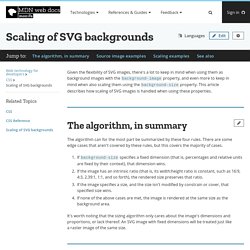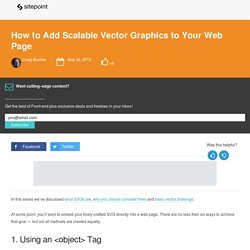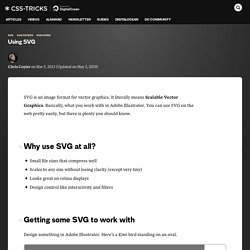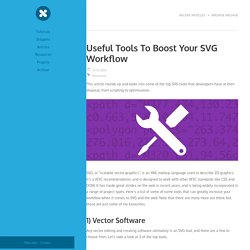

Scaling of SVG backgrounds - CSS. Given the flexibility of SVG images, there's a lot to keep in mind when using them as background images with the background-image property, and even more to keep in mind when also scaling them using the background-size property.

This article describes how scaling of SVG images is handled when using these properties. The algorithm, in summaryEdit The algorithm can for the most part be summarized by these four rules. There are some edge cases that aren't covered by these rules, but this covers the majority of cases. If background-size specifies a fixed dimension (that is, percentages and relative units are fixed by their context), that dimension wins. It's worth noting that the sizing algorithm only cares about the image's dimensions and proportions, or lack thereof. Source image examplesEdit In each case, we show what the source image looks like rendered in a 150x150 box, and provide a link to the SVG source. How to Scale SVG.
Share this: monday.com helps you manage your projects.

The following is a guest post by Amelia Bellamy-Royds. Amelia has lots of experience with SVG, as the co-author of SVG Essentials and author of the upcoming Using SVG with CSS3 and HTML5. Amelia and I both will be speaking on SVG at the upcoming RWD Summit as well! Here, she shares an epic guide to scaling SVG, covering all the ways you might want to do that. Until you open up your web page in test browsers and discover that some leave huge blocks of whitespace above and below the image, while others crop it off too short. How to Scale SVG. How to Add Scalable Vector Graphics to Your Web Page. In this series we’ve discussed what SVGs are, why you should consider them and basic vector drawings.

At some point, you’ll want to embed your finely-crafted SVG directly into a web page. There are no less than six ways to achieve that goal — but not all methods are created equally. 1. Using an <object> Tag If you intend using any advanced SVG features such as CSS and scripting, the HTML5 <object> tag is your best option: <object type="image/svg+xml" data="image.svg">Your browser does not support SVG</object> Note you can provide fallback text or images within the object block. 2.
I’m including <embed> for the purpose of completeness but don’t use it! Here’s the code. Icon System with SVG Sprites. I've been a big proponent of icon fonts.
Lots of sites really need a system for icons, and icon fonts offer a damn fine system. However, I think assuming you're good with IE 9+, using inline SVG and the <use> element to reference an icon is a superior system. First let's cover how it works. A nice way to handle your icons is to have a folder full of .svg files. They can be colored, not colored, multiple shapes, sizes, whatever. You can let Illustrator (or whatever) save it however, with all the cruft that comes along for the ride: Svg/svgo. Using SVG. Learn Development at Frontend Masters SVG is an image format for vector graphics.

It literally means Scalable Vector Graphics. Basically, what you work with in Adobe Illustrator. You can use SVG on the web pretty easily, but there is plenty you should know. Why use SVG at all? Small file sizes that compress wellScales to any size without losing clarity (except very tiny)Looks great on retina displaysDesign control like interactivity and filters Getting some SVG to work with Design something in Adobe Illustrator. Notice the artboard is cropped up right against the edges of the design. Node at Work: A Walkthrough. In my first article, “Even Better In-Browser Mockups with Node.js,” I explained why Node.js makes designing applications easier and more efficient, and how to get started.

Now it’s time to see your new design process in action. Article Continues Below Rather than figuring out all your requirements and API schemas just to design your comps with mockup content hard-coded and server interactions faked—only to throw it all away when you go back and implement things “for real”—you can use Node.js to skip the hard-coding and produce client-side code that’s ready for beta at the end of the design stage. The process looks a lot like good ol’ designing in the browser, but with more JavaScript and an additional layer: Design the layout and stylingConvert the markup to a JavaScript templateCreate an initialization functionCreate a simple Node.js serverAdd a mockup data object to the serverAdd server functions to serve static pages and JSONRequest and consume the JSON on the client Sound daunting?
Useful Tools To Boost Your SVG Workflow. SVG, or "scalable vector graphics", is an XML markup language used to describe 2D graphics.

It's a W3C recommendation, and is designed to work with other W3C standards like CSS and DOM. It has made great strides on the web in recent years, and is being widely incorporated in a range of project types.